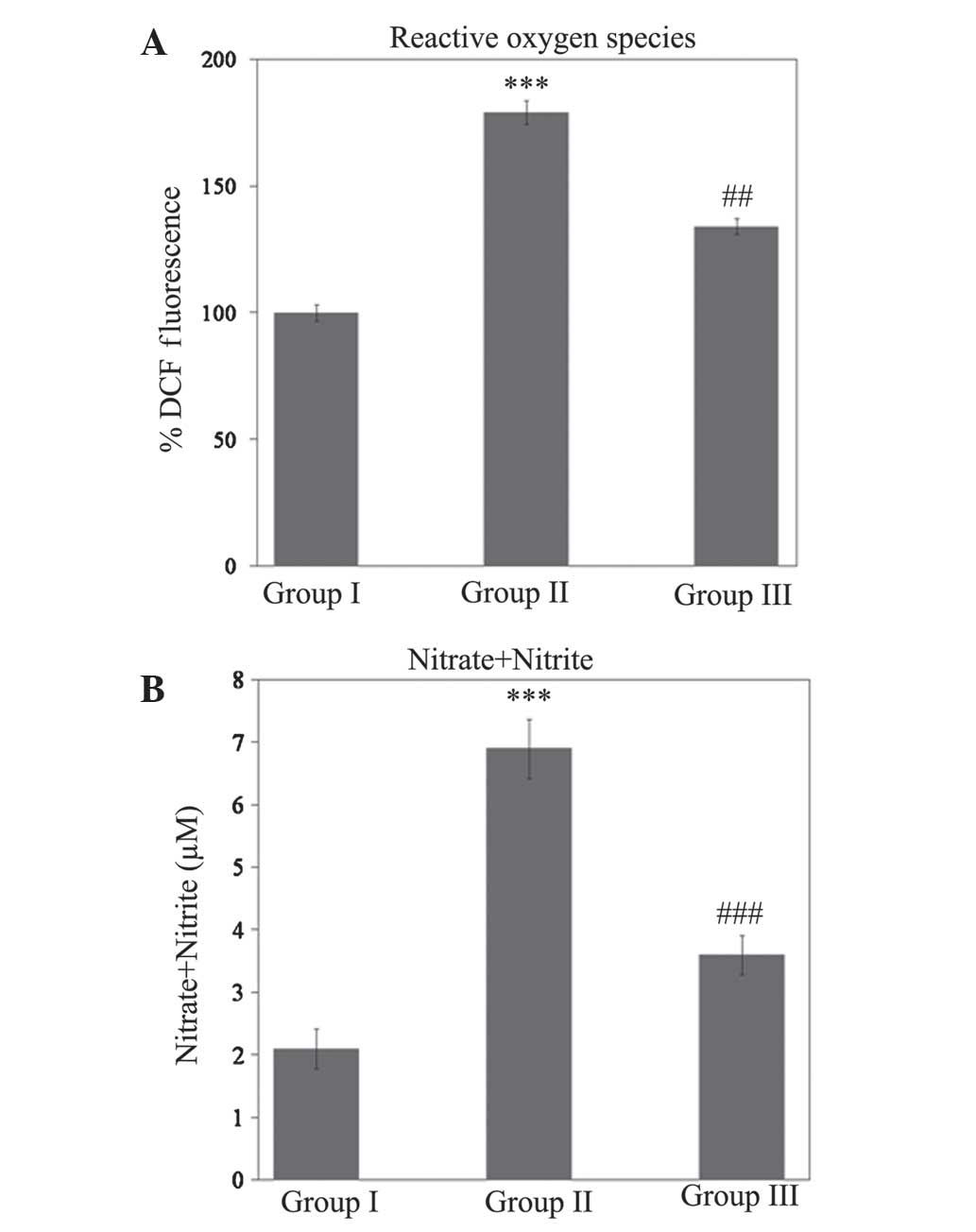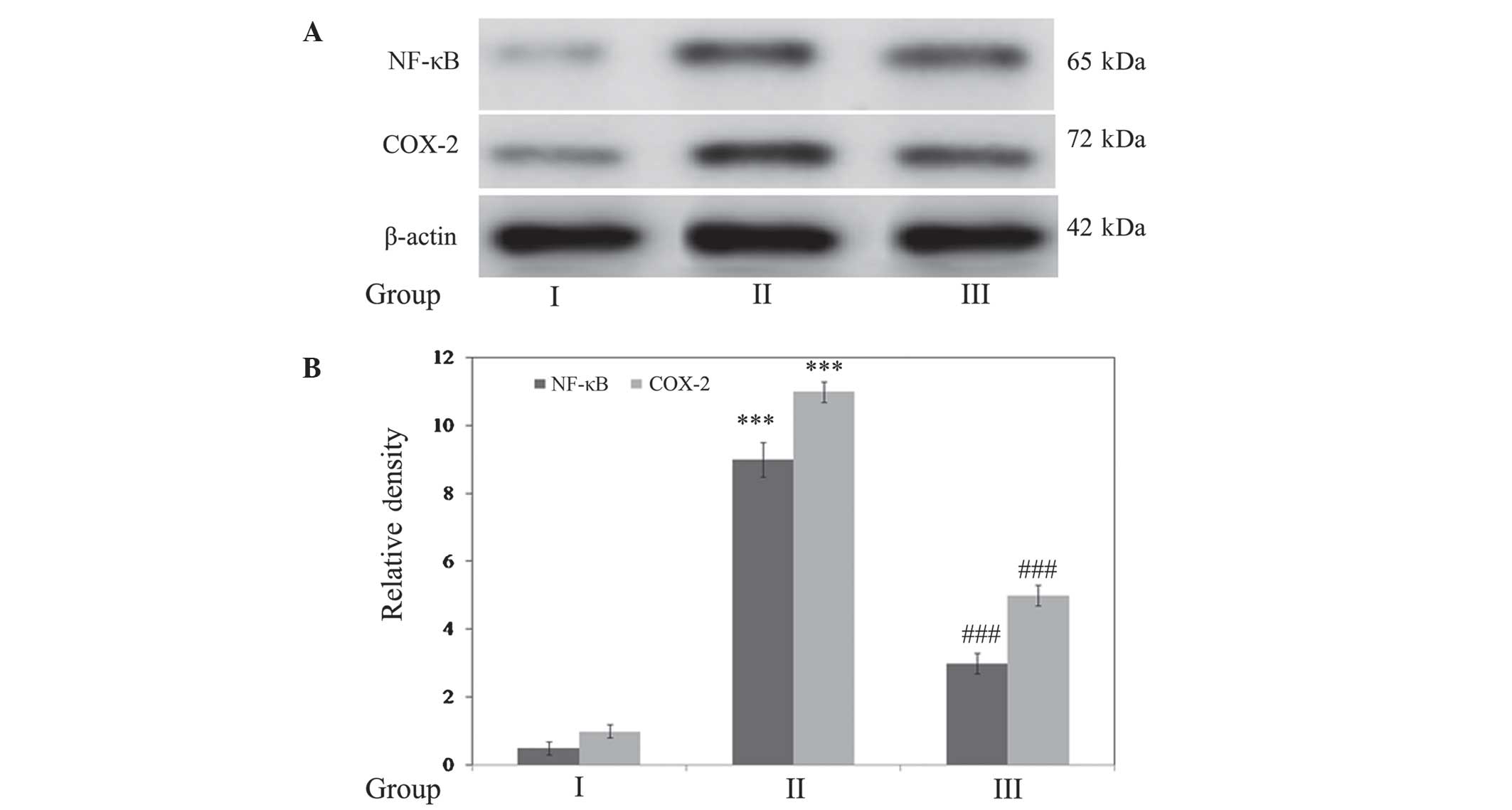|
1
|
Amar AP and Levy ML: Pathogenesis and
pharmacological strategies for mitigating secondary damage in acute
spinal cord injury. Neurosurgery. 44:1027–1039. 1999. View Article : Google Scholar : PubMed/NCBI
|
|
2
|
Hall ED: The role of oxygen radicals in
traumatic injury: clinical implications. J Emerg Med. 11(Suppl 1):
31–36. 1993.PubMed/NCBI
|
|
3
|
Hall ED: Lipid antioxidants in acute
central nervous system injury. Ann Emerg Med. 22:1022–1027. 1993.
View Article : Google Scholar : PubMed/NCBI
|
|
4
|
Hall ED: Antioxidant therapies for acute
spinal cord injury. Neurotherapeutics. 8:152–167. 2011. View Article : Google Scholar : PubMed/NCBI
|
|
5
|
Li L, Ng TB, Gao W, Li W, Fu M, Niu SM,
Zhao L, Chen RR and Liu F: Antioxidant activity of gallic acid from
rose flowers in senescence accelerated mice. Life Sci. 77:230–240.
2005. View Article : Google Scholar : PubMed/NCBI
|
|
6
|
Ng TB, He JS, Niu SM, Zhao L, Pi ZF, Shao
W and Liu F: A gallic acid derivative and polysaccharides with
antioxidative activity from rose (Rosa rugosa) flowers. J Pharm
Pharmacol. 56:537–545. 2004. View Article : Google Scholar : PubMed/NCBI
|
|
7
|
Giftson JS, Jayanthi S and Nalini N:
Chemopreventive efficacy of gallic acid, an antioxidant and
anticarcinogenic polyphenol, against 1,2-dimethyl hydrazine induced
rat colon carcinogenesis. Invest New Drugs. 28:251–259. 2010.
View Article : Google Scholar
|
|
8
|
Kroes BH, van den Berg AJ, Quarles van
Ufford HC, van Dijk H and Labadie RP: Anti-inflammatory activity of
gallic acid. Planta Med. 58:499–504. 1992. View Article : Google Scholar : PubMed/NCBI
|
|
9
|
Pellegrina CD, Padovani G, Mainente F,
Zoccatelli G, Bissoli G, Mosconi S, Veneri G, Peruffo A,
Andrighetto G, Rizzi C and Chignola R: Anti-tumour potential of a
gallic acid-containing phenolic fraction from Oenothera biennis.
Cancer Lett. 226:17–25. 2005. View Article : Google Scholar : PubMed/NCBI
|
|
10
|
Hsu CL, Lo WH and Yen GC: Gallic acid
induces apoptosis in 3T3-1 pre-adipocytes via a Fas- and
mitochondrial-mediated pathway. J Agric Food Chem. 55:7359–7365.
2007. View Article : Google Scholar : PubMed/NCBI
|
|
11
|
Inoue M, Suzuki R, Sakaguchi N, Li Z,
Takeda T, Ogihara Y, Jiang BY and Chen Y: Selective induction of
cell death in cancer cells by gallic acid. Biol Pharm Bull.
18:1526–1530. 1995. View Article : Google Scholar : PubMed/NCBI
|
|
12
|
Patel SS and Goyal RK: Cardioprotective
effects of gallic acid in diabetes-induced myocardial dysfunction
in rats. Pharmacognosy Res. 3:239–245. 2011. View Article : Google Scholar
|
|
13
|
Lowry OH, Rosebrough NJ, Farr AL and
Randall RJ: Protein measurement with the Folin phenol reagent. J
Biol Chem. 193:265–275. 1951.PubMed/NCBI
|
|
14
|
Erel O: A novel automated method to
measure total antioxidant response against potent free radical
reactions. Clin Biochem. 37:112–119. 2004. View Article : Google Scholar : PubMed/NCBI
|
|
15
|
Erel O: A new automated colorimetric
method for measuring total oxidant status. Clin Biochem.
38:1103–1111. 2005. View Article : Google Scholar : PubMed/NCBI
|
|
16
|
Levine RL, Garland D, Oliver CN, Amici A,
Climent I, Lenz AG, Ahn BW, Shaltiel S and Stantman ER:
Determination of carbonyl content in oxidatively modified proteins.
Methods Enzymol. 186:464–478. 1990.PubMed/NCBI
|
|
17
|
Esterbauer H and Cheeseman KH:
Determination of aldehydic lipid peroxidation products:
malonaldehyde and 4-hydroxynonenal. Methods Enzymol. 186:407–421.
1990.PubMed/NCBI
|
|
18
|
Hashimoto M, Tanabe Y, Fujii Y, Kikuta T,
Shibata H and Shido O: Chronic administration of docosahexaenoic
acid ameliorates the impairment of spatial cognition learning
ability in amyloid beta-infused rats. J Nutr. 135:549–555.
2005.PubMed/NCBI
|
|
19
|
Sun Y, Oberley LW and Li Y: A simple
method for clinical assay of superoxide dismutase. Clin Chem.
34:497–500. 1988.PubMed/NCBI
|
|
20
|
Aebi H: Catalase. Methods of Enzymatic
Analysis. Bergmeyer U: Academic Press; New York: pp. 673–677.
1974
|
|
21
|
Habig WH, Pabst MJ and Jakoby WB:
Glutathione S-transferases. The first enzymatic step in mercapturic
acid formation. J Biol Chem. 249:7130–7139. 1974.PubMed/NCBI
|
|
22
|
Paglia DE and Valentine WN: Studies on the
quantitative and qualitative characterisation of erythrocyte
glutathione peroxidase. J Lab Clin Med. 70:158–169. 1967.PubMed/NCBI
|
|
23
|
Bonting SL: Sodium-potassium activated
adenosine triphosphatase and cation transport. Membranes and Ion
Transport. Bittar EE: Wiley-Interscience; London: pp. 257–263.
1970
|
|
24
|
Ohnishi T, Suzuki T, Suzuki Y and Ozawa K:
A comparative study of plasma membrane Mg2+ -ATPase activities in
normal, regenerating and malignant cells. Biochim Biophys Acta.
684:67–74. 1982. View Article : Google Scholar : PubMed/NCBI
|
|
25
|
Hjertén S and Pan H: Purification and
characterization of two forms of a low-affinity Ca2+ -ATPase from
erythrocyte membranes. Biochim Biophys Acta. 728:281–288. 1983.
View Article : Google Scholar
|
|
26
|
Towbin H, Staehelin T and Gordon J:
Electrophoretic transfer of proteins from polyacrylamide gels to
nitrocellulose sheets: procedure and some applications. Proc Natl
Acad Sci USA. 76:4350–4354. 1979. View Article : Google Scholar : PubMed/NCBI
|
|
27
|
Hall ED and Braughler JM: Central nervous
system trauma and stroke. II Physiological and pharmacological
evidence for involvement of oxygen radicals and lipid peroxidation.
Free Radic Biol Med. 6:303–313. 1989. View Article : Google Scholar
|
|
28
|
Tator CH and Fehlings MG: Review of the
secondary injury theory of acute spinal cord trauma with emphasis
on vascular mechanisms. J Neurosurg. 75:15–26. 1991. View Article : Google Scholar : PubMed/NCBI
|
|
29
|
Faden AI: Therapeutic approaches to spinal
cord injury. Adv Neurol. 72:377–386. 1997.PubMed/NCBI
|
|
30
|
Faden AI and Salzman S: Pharmacological
strategies in CNS trauma. Trends Pharmacol Sci. 13:29–35. 1992.
View Article : Google Scholar : PubMed/NCBI
|
|
31
|
Hall ED and Braughler JM: Free radicals in
CNS injury. Res Publ Assoc Res Nerv Ment Dis. 71:81–105.
1993.PubMed/NCBI
|
|
32
|
Koc RK, Akdemir H, Karakücük EI, Oktem IS
and Menkü A: Effect of methylprednisolone, tirilazad mesylate and
vitamin E on lipid peroxidation after experimental spinal cord
injury. Spinal Cord. 37:29–32. 1999. View Article : Google Scholar : PubMed/NCBI
|
|
33
|
Halliwell B and Gutteridge JM: Oxidative
stress. Free Radicals in Biology and Medicine. 3rd. Oxford
University Press; New York: pp. 246–350. 1999
|
|
34
|
Greenberg ME, Li XM, Gugiu BG, Gu X, Qin
J, Salomon RG and Hazen SL: The lipid Whisker model of the
structure of oxidized cell membranes. J Biol Chem. 283:2385–2396.
2008. View Article : Google Scholar
|
|
35
|
West JD and Marnett LJ: Endogenous
reactive intermediates as modulators of cell signaling and cell
death. Chem Res Toxicol. 19:173–194. 2006. View Article : Google Scholar : PubMed/NCBI
|
|
36
|
Christie SD, Comeau B, Myers T, Sadi D,
Purdy M and Mendez I: Duration of lipid peroxidation after acute
spinal cord injury in rats and the effect of methylprednisolone.
Neurosurg Focus. 25:E52008. View Article : Google Scholar : PubMed/NCBI
|
|
37
|
Diaz-Ruiz A, Rios C, Duarte I, Correa D,
Guizar-Sahagun G, Grijalva I, Madrazo I and Ibarra A: Lipid
peroxidation inhibition in spinal cord injury: cyclosporin-A vs.
methylprednisolone. Neuroreport. 11:1765–1767. 2000. View Article : Google Scholar : PubMed/NCBI
|
|
38
|
Price A, Lucas PW and Lea PJ: Age
dependent damage and glutathione metabolism in ozone fumigated
barley: a leaf section approach. J Exp Bot. 41:1309–1317. 1990.
View Article : Google Scholar
|
|
39
|
Kim KT, Kim MJ, Cho DC, Park SH, Hwang JH,
Sung JK, Cho HJ and Jeon Y: The neuroprotective effect of treatment
with curcumin in acute spinal cord injury: laboratory
investigation. Neurol Med Chir (Tokyo). 54:387–394. 2014.
View Article : Google Scholar
|
|
40
|
Khalatbary AR and Ahmadvand H:
Neuroprotective effect of oleuropein following spinal cord injury
in rats. Neurol Res. 34:44–51. 2012. View Article : Google Scholar
|
|
41
|
Nabavi SF, Habtemariam S, Jafari M, Sureda
A and Nabavi SM: Protective role of gallic acid on sodium fluoride
induced oxidative stress in rat brain. Bull Environ Contam Toxicol.
89:73–77. 2012. View Article : Google Scholar : PubMed/NCBI
|
|
42
|
Ramkumar K, Vijayakumar R, Vanitha P,
Suganya N, Manjula C, Rajaguru P, Sivasubramanian S and Gunasekaran
P: Protective effect of gallic acid on alloxan-induced oxidative
stress and osmotic fragility in rats. Hum Exp Toxicol. 33:638–649.
2013. View Article : Google Scholar : PubMed/NCBI
|
|
43
|
Mansouri MT, Farbood Y, Sameri MJ, Sarkaki
A, Naghizadeh B and Rafeirad M: Neuroprotective effects of oral
gallic acid against oxidative stress induced by 6-hydroxydopamine
in rats. Food Chem. 138:1028–1033. 2013. View Article : Google Scholar : PubMed/NCBI
|
|
44
|
Kurtoglu T, Basoglu H, Ozkisacik EA, Cetin
NK, Tataroglu C, Yenisey C and Discigil B: Effects of cilostazol on
oxidative stress, systemic cytokine release, and spinal cord injury
in a rat model of transient aortic occlusion. Ann Vasc Surg.
28:479–488. 2014. View Article : Google Scholar : PubMed/NCBI
|
|
45
|
Carroll JE, Hess DC, Howard EF and Hill
WD: Is nuclear factor-kappaB a good treatment target in brain
ischemia/reperfusion injury? Neuroreport. 11:R1–4. 2000.PubMed/NCBI
|
|
46
|
Maihöfner C, Schlötzer-Schrehardt U,
Gühring H, Zeilhofer HU, Naumann GO, Pahl A, Mardin C, Tamm ER and
Brune K: Expression of cyclooxygenase-1 and -2 in normal and
glauco-matous human eyes. Invest Ophthalmol Vis Sci. 42:2616–2624.
2001.
|
|
47
|
Yamamoto T and Nozaki-Taguchi N: Analysis
of the effects of cyclooxygenase (COX)-1 and COX-2 in spinal
nociceptive transmission using indomethacin, a non-selective COX
inhibitor and NS-398, a COX-2 selective inhibitor. Brain Res.
739:104–110. 1996. View Article : Google Scholar : PubMed/NCBI
|
|
48
|
Morais MC, Luqman S, Kondratyuk TP,
Petronio MS, Regasini LO, Silva DH, Bolzani VS, Soares CP and
Pezzuto JM: Suppression of TNF-α induced NFκB activity by gallic
acid and its semi-synthetic esters: possible role in cancer
chemoprevention. Nat Prod Res. 24:1758–1765. 2010. View Article : Google Scholar : PubMed/NCBI
|
|
49
|
Choi KC, Lee YH, Jung MG, Kwon SH, Kim MJ,
Jun WJ, Lee J, Lee JM and Yoon HG: Gallic acid suppresses
lipopolysaccharide-induced nuclear factor-kappaB signaling by
preventing RelA acetylation in A549 lung cancer cells. Mol Cancer
Res. 7:2011–2021. 2009. View Article : Google Scholar : PubMed/NCBI
|
|
50
|
Bains M and Hall ED: Antioxidant therapies
in traumatic brain and spinal cord injury. Biochim Biophys Acta.
1822:675–684. 2012. View Article : Google Scholar
|
|
51
|
Fleming JC, Norenberg MD, Ramsay DA,
Dekaban GA, Marcillo AE, Saenz AD, Pasquale-Styles M, Dietrich WD
and Weaver LC: The cellular inflammatory response in human spinal
cords after injury. Brain. 129:3249–3269. 2006. View Article : Google Scholar : PubMed/NCBI
|
|
52
|
Oyinbo CA: Secondary injury mechanisms in
traumatic spinal cord injury: A nugget of this multiply cascade.
Acta Neurobiol Exp (Wars). 71:281–299. 2011.
|
|
53
|
Carageorgiou H, Tzotzes V, Pantos C,
Mourouzis C, Zarros A and Tsakiris S: In vivo and in vitro effects
of cadmium on adult rat brain total antioxidant status,
acetylcholinesterase, (Na+, K+)-ATPase and Mg2+-ATPase activities:
protection by L-cysteine. Basic Clin Pharmacol Toxicol. 94:112–118.
2004. View Article : Google Scholar : PubMed/NCBI
|
|
54
|
Vijaya Padma V, Poornima P, Prakash C and
Bhavani R: Oral treatment with gallic acid and quercetin alleviates
lindane-induced cardiotoxicity in rats. Can J Physiol Pharmacol.
91:134–140. 2013. View Article : Google Scholar : PubMed/NCBI
|
















